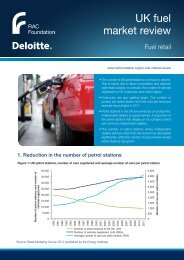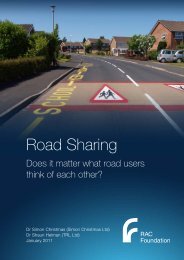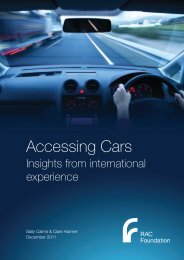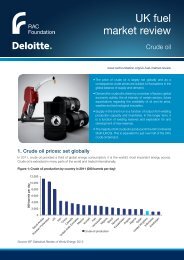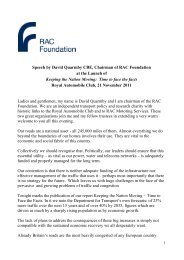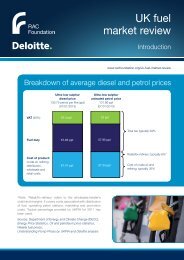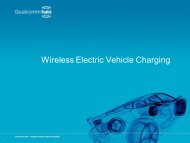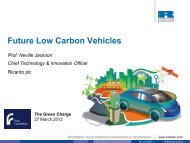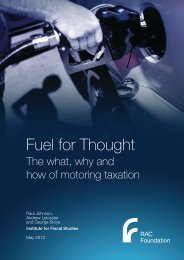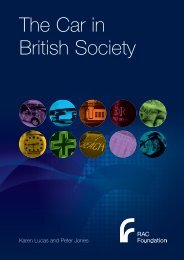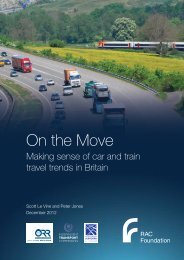The Case for High Speed Rail - An update - Preston - RAC Foundation
The Case for High Speed Rail - An update - Preston - RAC Foundation
The Case for High Speed Rail - An update - Preston - RAC Foundation
- No tags were found...
You also want an ePaper? Increase the reach of your titles
YUMPU automatically turns print PDFs into web optimized ePapers that Google loves.
iiAbstractThis paper was commissioned by the <strong>RAC</strong> <strong>Foundation</strong> in May 2010 to examinethree pieces of evidence published in March 2010 concerning the case <strong>for</strong> <strong>High</strong><strong>Speed</strong> <strong>Rail</strong> (HSR) in Britain. It builds on earlier work commissioned from theauthor and published in October 2009 to provide a rapid review of emergingevidence on the case <strong>for</strong> HSR. <strong>The</strong> aim of this paper is, in the light of thisnew evidence, to <strong>update</strong> the earlier paper, in particular with respect to: (i) theeconomic benefits and costs; (ii) the financial liability <strong>for</strong> the public purse; (iii)net carbon savings; and (iv) planning issues.It finds that there is an economic case <strong>for</strong> HSR from London to Birmingham(HS2), and beyond to Leeds and Manchester, but that this is dependent onassumptions concerning the long-term growth in demand <strong>for</strong> long-distance railpassenger traffic. However, mid-scale improvements to existing road and railinfrastructure may provide better economic returns and these should be furtherinvestigated. <strong>The</strong>re does not appear to be an economic case <strong>for</strong> a direct link toeither Heathrow or to the international services provided by HS1 (the ChannelTunnel <strong>Rail</strong> Link).It also finds that HSR costs are exceptionally high in the UK and hence, despiterelatively high levels of demand, substantial subsidy is required. For the HS2scheme between London and Birmingham, this support would be around £12billion (2009 prices), which is to say around two-thirds of the capital costs. Howthis funding is delivered remains to be determined. <strong>The</strong>re may be some scopeto reduce costs and increase revenue from the HS2 scheme, but this could beat the expense of social returns.<strong>The</strong> paper confirms earlier work that found that HSR has modest environmentaland wider economic benefits, over and above the mainstream transportbenefits. It also confirms that building an HSR line is a major enterprise whichwould take around eleven years, whilst the HS2 proposals are strongly linkedto Crossrail, which is scheduled to be completed in 2017. <strong>The</strong> earliest that HS2might be completed is 2026. Planning may be complicated by the proposals toabolish the Infrastructure Planning Commission.
1<strong>The</strong> case <strong>for</strong> high speed rail - an <strong>update</strong>1. IntroductionThis paper was commissioned by the <strong>RAC</strong><strong>Foundation</strong> in May 2010 to examine threepieces of evidence published in March 2010concerning the case <strong>for</strong> <strong>High</strong> <strong>Speed</strong> <strong>Rail</strong> (HSR)in Britain.<strong>The</strong>se were:• <strong>The</strong> Command Paper (Cm7827) on HSR, published by theDepartment <strong>for</strong> Transport (DfT) and running to some 152pages.• A report to Government entitled <strong>High</strong> <strong>Speed</strong> <strong>Rail</strong>: Londonto the West Midlands and Beyond that was produced by<strong>High</strong> <strong>Speed</strong> Two Limited (HS2 Ltd), an independent bodyestablished in January 2009 to develop a new HSR linebetween London and the West Midlands and to considerthe case <strong>for</strong> HSR services linking London, northernEngland and Scotland. <strong>The</strong> main report was published in11 parts, running to some 247 pages. In addition, a set of13 supporting documents was produced. <strong>The</strong> creation ofthese documents involved panels of some 25 experts andconsultation with some 200 interested parties.• A series of four reports produced by the engineeringconsultancy Atkins and commissioned by the DfT as part ofthe <strong>High</strong> <strong>Speed</strong> 2 Strategic Alternatives Study.
Introduction 4likely congestion of connecting public transport modes at Old Oak Common ifthis were to be the London terminus.If a rail link is to be built between HS1 and HS2 it is recommended that itshould be double track at conventional speed, between Old Oak Common andCamden Road East Junction. This would have an estimated cost in excessof £1 billion. <strong>The</strong> Mawhinney Report states that ‘It makes sense if possibleto create a seamless link between H1 and HS2’ (paragraph 63), but it is alsoacknowledged that further work is required.<strong>The</strong> proposed HS2 service would result in a journey time of 49 minutesbetween London Euston and Birmingham Fazeley Street, by comparisonwith the current journey time of around 82 minutes (Euston to New Street) – astation-to-station speed increase of around 67%. <strong>The</strong> journey time betweenBirmingham Interchange and Old Oak Common would be 31 minutes, whichhas <strong>for</strong>med the basis of the Command Paper’s claim of journey times betweenLondon and Birmingham of around 30 minutes. Services to the north usingHS2 would benefit from time savings of around 30 minutes.<strong>The</strong> basic off-peak service pattern assumes three services between Londonand Birmingham, three between London and Manchester, two between Londonand Liverpool and one between London and Glasgow (HS2, 2010: 148). <strong>An</strong>additional service in the peaks between London and <strong>Preston</strong> is proposed,along with supplementation of the London–Birmingham service.<strong>The</strong> provision of HS2 would allow a recasting of the WCML timetable. Inparticular, this would allow additional services <strong>for</strong> the Milton Keynes SouthMidlands Growth Area. For example, it is proposed that Milton Keynes wouldreceive up to eight non-stop services to London in the peak hour, with fivefurther stopping services, and enhanced services northwards, these being toCrewe, Glasgow, Liverpool and Manchester (Technical Appendix, pp. 14–21).
5<strong>The</strong> case <strong>for</strong> high speed rail - an <strong>update</strong>Detailed rail demand modelling has been undertaken using the PLANET model(the DfT strategic rail demand <strong>for</strong>ecasting model). It should be noted that HSRhas not been modelled as a new mode, but as an incremental improvementto the existing rail system. Without HS2, around 106,000 long-distancepassengers are <strong>for</strong>ecast to be using the southern part of the WCML per dayin 2033. By contrast, the southern section of the HS2 route is <strong>for</strong>ecast to becarrying 145,000 passengers per day, with a reduction of 84,000 passengerson the baseline classic network. 2 Of these, around 54,000 HS2 trips per daywould be to/from the Birmingham stations (37%), with the balance comingfrom further north. Around 30% of travel would be <strong>for</strong> business. Some 57% ofjourneys would switch from classic rail, 8% would be from air, 8% from car and27% would be generated. HS2 would thus have a higher level of abstractionfrom rail and a lower level of abstraction from road and, even more so, air thanthe other HSR schemes shown in Table 1.Table 1: Diversion factors resulting from introduction of HSRRoute Paris–Lyons 1430 kmMadrid–Seville 2471 kmMadrid–Barc’a 3630 kmThalys 4 Eurostar4% HST trafficgenerated from1980 to 1985 1991 to 1996<strong>for</strong>ecastBe<strong>for</strong>e HSR’to ‘After HSR’Range notgivenRange notgivenInduced 29 50 20 11 20Road 11 6 10 34 19Conventional rail 40 20 10 47 12Air 20 24 60 8 49Note: * All Paris–Lyon’s ‘after’ rail travel is presumed to be by HST (i.e. none by conventional rail followingintroduction of HST), since the alternative journey time is approx. five hours compared with approx. twohours by HST.Sources: 1 Bonnafous (1987) 2 de Rus & Inglada (1997) 3 Coto-Millán et al. (2007) 4 Segal (2006) quoted in<strong>Preston</strong> (2009)It should be noted that this is a relatively high level of demand, equatingto almost 44 million passengers per annum (assuming an annualisationfactor of 300 – see Demand <strong>An</strong>alysis Report, p. 90). This would appear tobe com<strong>for</strong>tably above the social break-even figure of 9 million (but <strong>for</strong> a 500km route – the preferred HS2 route 3 is 175 km) 3 developed by de Rus andNash (2009: 66). Gourvish (2010) reports that in 1992 there were 23 million railpassengers between Paris and Lyon (some eleven years after the introduction2 This implies 22,000 still using WCML with HS2 and classic rail usage on the corridor totalling 167,000,an increase of around 57%.3 This is to a common point near Birmingham (HS2, 2010: 99). <strong>The</strong> distance from Euston to theconnection with WCML is estimated to be 189 km, whilst the entire HS2 build is 205 km.
Introduction 6of TGV services). <strong>The</strong> Command Paper (p. 38) notes that there are 150 millionrail passengers per annum between Tokyo and Osaka.<strong>High</strong> speed routes beyond Birmingham have also been considered, albeitat a much less detailed level than the London–Birmingham route, with threebroad networks considered: the ‘inverse A’, the ‘reverse S’ and the ‘reverse E’.This strategic analysis indicated that the inverse A per<strong>for</strong>med best, a variantof which (the ‘Y network’) was subject to further analysis. This would involvetwo branches, one to Manchester and the other to Leeds, with intermediatestations on the latter in the East Midlands and in South Yorkshire. This wouldlead to rail journeys from London to Leeds reducing by one hour (from 140to 80 minutes). Journey times from Manchester to London would also be 80minutes, compared with the current 128. However, HS2 would reduce thejourney time between London and Manchester to around 100 minutes, so thejourney time reduction <strong>for</strong> the extension to Manchester would only be 20%,compared with a reduction of over 40% <strong>for</strong> Leeds. <strong>The</strong> inverse A network was<strong>for</strong>ecast to be used by around 440,000 passengers per day in 2033, of which219,000 would be to/from London. Total annual usage of the inverse A networkwould thus be around 132 million – a figure comparable with the TokaidoShinkansen. It is estimated that compared with HS2, a Manchester branchwould lead to an increase in London-based traffic of a little over 9,000 tripsper day, whereas the Leeds branch would lead to an increase of some 70,000trips per day. 4 <strong>The</strong> Manchester branch would also stimulate around 7,400 non-London daily trips, with the figure <strong>for</strong> the Leeds branch being around 19,000.4 This would suggest London traffic up from 140,000 to 214,000 per day as a result of the Leeds andManchester extensions – an increase of 56%.
7<strong>The</strong> case <strong>for</strong> high speed rail - an <strong>update</strong>2. <strong>The</strong> Economic Benefitsand Costs of HSR<strong>The</strong> HS2 studies have contributed furtherevidence on the economics of HSR in Britain,and this is now reviewed in three sections.In section 2.1, costs are examined, then insection 2.2 benefits are examined, be<strong>for</strong>e insection 2.3 the interplay of costs and benefitsis considered.2.1Costs<strong>The</strong> Command Paper (p. 68) indicates that the costs <strong>for</strong>the 128 miles (205 km) of HS2 route between London andBirmingham would be between £15.8 billion and £17.4 billion,whilst the 335 mile (536 km) Y-shaped network would cost atotal of around £30 billion (2009 prices). This suggests highunit costs of around £77 million to £85 million per km <strong>for</strong>HS2, compared with around £53 million per km <strong>for</strong> the Leeds/Manchester extensions. <strong>The</strong> higher unit costs <strong>for</strong> HS2 reflectthe greater burden of the terminals and the greater proportionof tunnelling.Rolling stock costs are given as £472 million <strong>for</strong> 16 HS captivesets (with a risk provision of 18%) and £2,363 million <strong>for</strong> 45HS classic-compatible sets (with a 40% risk provision). Amaintenance cost of £2.80 per km has been assumed <strong>for</strong> HScaptive trains and £3.50 <strong>for</strong> the classic-compatible sets. Energyconsumption has been estimated at £2.80 per km.
<strong>The</strong> economic benefits and costs of HSR 8For the extensions to Manchester and Leeds some simple unit rates perkm were used <strong>for</strong> route over flat terrain (£11 million), over undulating terrain(£17.5 million), through urban areas (£25 million) and in tunnel (£80 million).For stations, costs of £150 million <strong>for</strong> a two-plat<strong>for</strong>m through station and £240million <strong>for</strong> a four-plat<strong>for</strong>m terminal station were used. <strong>An</strong> appraisal optimismuplift of 66% was used.<strong>The</strong>se costs are much higher than many other HS schemes (see, <strong>for</strong> example,Campos & de Rus, 2009). Comparisons with two schemes in France, two inGermany and one each in Italy and Spain, undertaken by BSL ManagementConsultants <strong>for</strong> HS2 Ltd, indicated that, when adjusting <strong>for</strong> urban approachesand tunnelling, unit construction costs in the UK appeared to be double thosein mainland Europe. A number of reasons were given <strong>for</strong> this. Constructionin Europe tended to be undertaken as a rolling programme which leads toeconomies of experience whereas in the UK, HS1 (which was used as the basis<strong>for</strong> HS2 costs) was a one-off project that required more direct supervision. Itwas also speculated that the more prescriptive approach to transposition of EUlegislation in the UK has led to increased costs. Multiple subcontracting wasalso thought to be cost inflating as each commercial layer adds overheads andprofit margins, whilst the complexity of the necessary contractual arrangementsrequires large external project management teams. <strong>The</strong> addition of an optimismbias element may also create self-fulfilling project price inflation.2.2Benefits<strong>The</strong> HS2 scheme is expected to generate benefits of some £32 billion (PresentValue) and net revenue of almost £15 billion over sixty years. Over 85% ofbenefits come from traditional transport user benefits such as time savings,crowding relief and reliability improvements. Of these transport user benefitsaround £2.5 billion (slightly less than 10%) are due to reliability improvements(HS2 Demand Model <strong>An</strong>alysis: 157). It is estimated that HS2 generates anaverage benefit of £8 per trip (HS2, 2010: 174). 55 From the Demand Model <strong>An</strong>alysis Report (p. 39) and the Model Development Report (p. 65), and giventhat 30% of traffic is <strong>for</strong> business, an average appraisal value of time of around 25 pence per minute canbe inferred. This suggests that the average benefit is equivalent to a time saving of around 32 minutes.
9<strong>The</strong> case <strong>for</strong> high speed rail - an <strong>update</strong>Of these transport user benefits, more than £20 billion accrue to HS2passengers (mainly due to improved journey times), up to £4 billion accrue topassengers on the classic line (due to reduced overcrowding and increasedfrequency) and £2 billion to road users (due to reduced congestion – <strong>for</strong>example, traffic on the southern section of the M1 is <strong>for</strong>ecast to fall by around2%). It should be noted that 61% of the transport user benefits accrue tobusiness users (who only make up 30% of passengers), reflecting the highervalues of time <strong>for</strong> this group (which can be up to seven times higher than thevalues <strong>for</strong> leisure travellers).<strong>The</strong> other main source of benefits is related to the wider economy, withagglomeration benefits and the reduction in imperfect competition in thebusiness sector, which when taken together are estimated to lead to benefits of£3.6 billion. <strong>The</strong>re are also some small positive impacts related to accidents, airquality and noise, but these only amount to less than £100 million.<strong>The</strong> extension to Manchester is <strong>for</strong>ecast to have incremental transport userbenefits of £8.1 billion, whilst the corresponding figure <strong>for</strong> the Leeds extensionis £30.4 billion.2.3Interplay of Costs and Benefits<strong>The</strong> findings of the HS2 studies add to the considerable evidence from ex anteappraisals of HSR in Britain (National Audit Office, 2001; Atkins, 2003; Atkins,2008; <strong>Preston</strong> et al., 2009; Network <strong>Rail</strong>, 2009; Greengauge 21, 2009). Some ofthe key findings of these reports are summarised in Table 2.Table 2: Reported Benefit Cost Ratios (BCRs) of recent HSRstudies in BritainSource Description BCRFull Networks Atkins, 2003Atkins, 2008Network <strong>Rail</strong>, 2009Greengauge 21, 2009Option 1.4.12.02.01.83.5Individual Lines Atkins, 2003 1Atkins, 2008Network <strong>Rail</strong>, 2009Greengauge 21, 2009London–West Midlands 2.1East Coast2.5West Coast1.5London–Manchester 0.9HS NW Phase 1 2 2.9HS NE Phase 1 3 2.01As reported by de Rus and Nash (2009) 2 London–Manchester 3 London–NewcastleSource: <strong>Preston</strong> (2009)
<strong>The</strong> economic benefits and costs of HSR 10Table 3 summarises the results from the HS2 studies. It should be notedthat the results <strong>for</strong> the HS2 route from London to Birmingham are not strictlycomparable to those <strong>for</strong> the Manchester and Leeds extensions, as the <strong>for</strong>merhas been analysed to a much greater degree of detail than the latter. However,it can be see that the HS2 line with a BCR of 2.4 is consistent with previousestimates <strong>for</strong> individual lines, albeit towards the top end. It should be notedthat the BCR of HS2 plus the Manchester extension is also around 2.4, slightlylower than the 2.9 estimated by Greengauge 21 (2009) <strong>for</strong> their HS NW Phase1. A feature of the HS2 long-term strategic analysis is the very strong economicper<strong>for</strong>mance of an extension to Leeds, which is estimated as having a BCR ofaround 25. As a result, the provisional BCR of the Y-shaped network is around4, which is higher than any of the previous estimates <strong>for</strong> a full network.It should be noted that the net benefits in Table 3 refer to transport userbenefits only. For HS2, the benefits from wider economic impacts are estimatedto be worth £3.6 billion, increasing benefits by 12% and raising the BCR to 2.7.Table 3: Appraisal results of HS2 studies (£ million, PV 2009prices)HS2ManchesterExtensionLeedsExtensionFull NetworkNet Benefits 28,700 8,100 30,300 67,100Net Costs 11,900 3,700 1,200 16,800BCR 2.4 2.2 25 4.0NPV* 16,800 4,400 29,100 50,300Note: figures <strong>for</strong> Manchester and Leeds extensions from HS2 Demand Model <strong>An</strong>alysis (pp. 131 & 133)* Net Present Value<strong>The</strong>re appears to be a case <strong>for</strong> HSR investment but these results arepredicated on continued growth in the demand <strong>for</strong> long-distance rail travel ofaround 3.3% per annum up to 2033 (after which the market is assumed to besaturated). 6 However, if this assumed growth reduces by around a half, thenthe BCR of HS2 falls to a value of around one (HS2, 2010: 187), illustrating theimportance of this assumption. Similarly if background growth of 3.3% perannum only lasted up to 2022, then the BCR of HS2 would fall to a value ofaround one. Latest Office of <strong>Rail</strong> Regulation (ORR) data indicate that year-onyeargrowth in the long-distance rail market was 3.7% if comparing 2009/10with 2008/9, and 9.3% if comparing Quarter 1 2010/11 with Quarter 1 2009/10.This suggests that this market has been relatively recession-proof.6 This assumed growth period is longer than that of the DfT, whose standard practice is to cap demandfrom 2026 onwards.
11<strong>The</strong> case <strong>for</strong> high speed rail - an <strong>update</strong>This contrasts with the London and South East market, which reduced by 1.8%between 2008/9 and 2009/10, but with some signs of a recovery as demandhas increased by 2.4% between Quarter 1 2009/10 and Quarter 1 2010/11.<strong>An</strong> important issue in appraisal relates to the definition of the base case(do-minimum) and alternative (do-something-else) scenarios. This issue wasinvestigated by Atkins, who examined alternative investments in classic railand in road. <strong>The</strong>ir findings are summarised in Table 4.Table 4: Economic summary statistics <strong>for</strong> alternatives to HS2(£ million, 2009 price)<strong>Rail</strong> package 2 Road package 2 BothPVB 7,349 5,136 12,485PVC 2,025 1,403 3,428BCR 3.6 3.7 3.6NPV 5,325 3,732 9,057Source: Strategic Outline <strong>Case</strong> (pp. 58 & 63). PVB = Present Value of Benefits, PVC = Present Value ofCosts. <strong>The</strong> rail package assumes rolling stock treated as a capital cost. If rolling stock is leased, theBCR reduces to 2.8. Note also that road package 2 corresponds to the mid-scale road package in theCommand Paper (p. 51). <strong>The</strong> mid-scale rail package in the Command Paper is based on Atkins’ railpackage 2A, which involved the reinstatement of additional journey time (of around three minutes <strong>for</strong>London to Manchester via Wilmslow) to assist recovery from delays and incidents. <strong>The</strong> Command Paperalso assumes rolling stock is leased, resulting in a BCR of 2.2.<strong>Rail</strong> package 2 involves increases in frequencies on the WCML through aseries of infrastructure improvements including a Staf<strong>for</strong>d bypass, threenew plat<strong>for</strong>ms at London Euston and Manchester Piccadilly, four-tracking(Attleborough–Brinklow, Beechwood Tunnel–Stech<strong>for</strong>d), grade separation(between Cheddington and Leighton Buzzard and at Ardwick) and speedimprovements in the Northampton area. Road package 2 involves the widespread adoption of hard shoulder running (255 miles), plus some widening ofthe M42 and M25 (34 miles). <strong>The</strong> impacts of the road packages were modelledusing the National Transport Model.It can be seen from Table 4 that both the road and rail improvements haveBCRs in excess of those <strong>for</strong> HS2 in Table 3. Given budget constraints, strictinterpretation of these results would suggest that these schemes should beimplemented be<strong>for</strong>e the HS2 project and that they should be included in thebase case against which HS2 is appraised. However, both the road and railpackages are enhancements of existing infrastructure, and there may beconcerns that disruption costs are underestimated. <strong>The</strong> Command Paper (p. 50)
<strong>The</strong> economic benefits and costs of HSR 12notes that the WCML upgrade took almost a decade to complete, and the costsinvolved payments of more than £500 million to train operating companies incompensation <strong>for</strong> the disruption caused. 7 <strong>The</strong>re appears to be little governmentalappetite <strong>for</strong> a further WCML upgrade.<strong>The</strong> Command Paper also notes that the mid-scale rail upgrade packagewould only provide journey time improvements of around ten minutes (but seethe footnote to Table 4 above) and a maximum potential rail capacity increaseof around 50%. <strong>The</strong> mid-scale road improvement provides a potential roadcapacity increase of 20% and journey time improvements of around two tofour minutes. By contrast, a new HSR line is estimated to increase rail capacityby more than 200% and reduce journey times by 35 minutes, and thus hasadvantages in terms of connectivity. From Table 3, it can be seen that the NPVof HS2 is £16.8 billion, whilst from Table 4 it can be seen that the combinedNPV of rail package 2 and road package 2 (which are not strictly additive)is around £9.1 billion. This reduces to around £7.5 billion if rail package 2is replaced by 2A (as in the Command Paper). <strong>The</strong>se calculations are onlyindicative, but suggest that a mid-scale improvement of existing infrastructurecould achieve around half the net economic benefits of HS2.7 <strong>The</strong> provision in HS2 <strong>for</strong> such payments is £174m but this also includes possession/isolation costs.
13<strong>The</strong> case <strong>for</strong> high speed rail - an <strong>update</strong>3. <strong>The</strong> Financial Liability<strong>for</strong> the Public PurseGourvish (2010: 25) notes that the JapaneseTokaido and the French Sud-Est HSRschemes were not subsidised and appear tobe successful in financial terms. For example,<strong>for</strong> the latter, the capital investment was fullyamortised after twelve years.Despite higher traffic levels than TGV Sud-Est, this doesnot appear to be the case <strong>for</strong> HS2. Table 3 indicates thatgovernment support of around £11.9 billion would be required,representing around two-thirds of the capital costs of £17.8billion. For the full Y network, government support mightincrease to £16.8 billion out of total capital costs of £29 billion(58%). <strong>The</strong>se findings are broadly in line with earlier studies(Network <strong>Rail</strong>, 2009; Greengauge 21, 2009).One possible source of funding might come from the proceedsof the sale of HS1 (Speech by Environment Secretary CarolineSpelman, 1 September 2010), which has an estimated valueof £2 billion.
14<strong>The</strong> case <strong>for</strong> high speed rail - an <strong>update</strong>4. Net Carbon Savings andEnvironmental Impacts<strong>The</strong> HS2 studies confirm that HSR has a relatively modestimpact on carbon. HS2 carbon dioxide (CO 2) meanemissions are estimated at 19.7 million tonnes, whilst themean estimates are that there will be reductions of 0.9million tonnes <strong>for</strong> classic rail, 0.2 million tonnes <strong>for</strong> car and23.2 million tonnes <strong>for</strong> air. This gives a mean estimate ofa reduction of 4.6 million tonnes but a range is given froma decrease of 25 million tonnes to an increase of 26.6million. This should be compared with UK CO 2emissionsof 528 million tonnes in 2010, with 139 million tonnesfrom the transport sector. <strong>The</strong> variation in the estimatesis largely related to assumptions concerning the likelyresponse of airlines to HS2 (and the extent to whichflights are withdrawn) and the carbon intensity of electricitygeneration (the central case is based on the assumptionthat this will not reduce below 0.385 kgCO 2per kWh).It should be noted that these calculations assume arelatively high HS2 load factor of 60%.<strong>The</strong> total embedded carbon cost of construction, based onthe main bulk construction materials, has been estimatedat 1.2 million tonnes CO 2. This suggests that constructiononly accounts <strong>for</strong> 6% of carbon costs. This is lower than theestimates of Booz Allen and Hamilton (2007), who suggest afigure of around 26%, and Network <strong>Rail</strong> (2009d, Figure 3.1)who estimate a figure of 18% (but based on a CO 2-equivalentestimate of greenhouse gases). ADEME et al. (2009) haveundertaken detailed life cycle carbon cost calculations <strong>for</strong> theRhine Rhone TGV that indicate that only 53% of carbon costsare associated with traction energy, but this reflects the lowcarbon intensity of French electricity.
Net carbon savings and environmental impacts 15Other environmental impacts are dealt with in less detail by the HS2 studies.Noise and vibration is an important issue. Some 350 dwellings wouldexperience high noise levels and a much larger number would experiencesome increase. Some 9,400 houses located over tunnel sections couldexperience vibration impacts. Some of these impacts will be reduced bymitigation measures, with ancillary items including £215 million primarily <strong>for</strong>environmental mitigation – out of total costs of £16.5 billion (only 1.3% ofcosts). However, many other cost items will play a mitigation role. Other studies(such as Temple, 2007) suggest up to 10% of construction costs may berelated to environmental mitigation measures.Although the route has been chosen to minimise environmental impacts (andwork on this is ongoing), there would be important impacts on landscape,townscape, biodiversity and water courses. <strong>The</strong> HS2 route goes through theChilterns, an Area of Outstanding Natural Beauty, and measures are planned tomitigate the potential adverse impacts of this nationally protected landscape,with 37% of the route through this area in tunnels. <strong>The</strong>re would be a needto <strong>for</strong> property demolition, particularly around Euston and Old Oak Common(affecting some 260 dwellings in total). <strong>An</strong> Exceptional Hardship Scheme hasbeen established to fund compensation.Although internationally designated habitats and sites are avoided by the route,there are some nationally protected sites that are affected, including UftonFields SSSI (Site of Special Scientific Interest) near Leamington Spa. <strong>The</strong>rewill be some impact on watercourses, with short diversion of the Rivers Colne,Cole, Tame and Rea, and some potential impact on aquifers in the Colne Valley,and between Brackley and Kenilworth. Some 17 km of the route will be builtin high-risk flood areas. However, HS2 concluded that these non-monetisedimpacts are unlikely to be large enough to alter the conclusion that the schemewould deliver high value <strong>for</strong> money.
16<strong>The</strong> case <strong>for</strong> high speed rail - an <strong>update</strong>5. Planning IssuesAlthough HS2 is not being primarily advocatedas a spatial planning tool, there will be someregeneration benefits, particularly in BirminghamEastside (linked to Fazeley Street), Park Royal(linked to Old Oak Common) and the LondonBorough of Camden (linked to Euston). <strong>The</strong>capacity released on the WCML will assist inthe development of the Milton Keynes SouthMidlands Growth Area where 225,000 newhouses and 200,000 new jobs are plannedover the next ten years.Work by Graham and Melo (2010) shows that althougheconomic theory does not preclude the existence ofagglomeration benefits across inter-regional distances, theempirical evidence suggests that these may be very small, atleast in relative terms. For example, a transport investment thatdirectly affects 25% of long-distance rail trips by increasingspeeds by 25% might increase the output of affectedareas by 0.0006% (or £8.29 million per annum). Even if thetransport investment affects 50% of long-distance rail tripsand has a 50% increase in speeds, the increase in output isonly 0.0022% (or £31.6 million per annum). Given the likelymeasurement errors with such calculations, it would seemsensible to underplay the wider economic impacts of HSR. <strong>The</strong>schemes will have also have some direct economic benefits.For example, over the seven years of construction, there wouldbe some 10,000 jobs created as a result.
Planning issues 17<strong>The</strong> planning of HS2 appears to be linked to Crossrail. Construction would notstart until Crossrail was completed in 2017. This would allow both human andfinancial resources to switch to HS2. <strong>An</strong> average annual rate of expenditureduring construction of £2 billion would be commensurate with Crossrail andother major projects such as the Olympic Park. <strong>The</strong> highest spend <strong>for</strong> HS2 in asingle year is estimated to be £3.9 billion.<strong>The</strong> Command Paper (pp. 138–140) gives some indicative timelines, assumingthe use of a single Hybrid Bill, as used by Crossrail, HS1 and the Dart<strong>for</strong>dCrossing. Following consultation, an initial mobilisation phase would involvetwo years, construction would be six and a half years, and testing andcommissioning would take a further two years. With this timetable it shouldbe possible <strong>for</strong> a London-to-Birmingham line to open by the end of 2026.However, following the election of a new government in May 2010, the initialconsultation phase has already been extended by around six months.HS2 Ltd recommends a largely public sector funding approach, with an arm’slength sponsoring body similar to the Olympic Delivery Authority. A singleinfrastructure company is also recommended to control the operations andmaintenance of HS2. It is believed that HS2 is too big to be a single publicprivatepartnership PPP – the total value of all PPPs in the UK in 2008 was£6.5 billion, approximately a third of HS2’s capital costs. Multiple PPPs arethought to be too complex; the Dutch Hogesnelheidslijn Zuid, which usedsuch a model, commenced operations two years later than planned. <strong>The</strong>recould be developer contributions towards station sites, whilst newbuild sitessuch as those in Birmingham could be delivered by ‘Design, Build, Financeand Maintain’ PPPs. Such PPPs could also be used to deliver the depotsand rolling stock. A recent report by Ross et al. (2010) suggests that HSRshould commence with a £6 billion scheme that runs from BirminghamAirport to Old Oak Common and which could be funded by a Special PurposeVehicle, whilst the Mawhinney Review (paragraph 29) appears sympatheticto a PPP approach. <strong>The</strong> method of delivery is likely to be a political bone ofcontention. <strong>An</strong>other issue will be the durability of the Planning Act 2008 andthe Infrastructure Planning Commission that it established.
18<strong>The</strong> case <strong>for</strong> high speed rail - an <strong>update</strong>6. Conclusions<strong>The</strong> HS2 reports have provided some claritywith respect to the case <strong>for</strong> HSR in Britain. Adetailed route has been determined betweenLondon and Birmingham and this haspermitted more detailed service planning andhence a more detailed estimation of costsand benefits than has hitherto been the case.<strong>The</strong>re has also been some important multimodalanalysis. Although there have beensome changes since publication, not least thecancellation of the third runway at Heathrow,these still constitute the most authoritative set ofreports on HSR in Britain to date.<strong>The</strong> HS2 reports confirm the findings of earlier studies thatthere appears to be a case <strong>for</strong> HSR between London andBirmingham, and beyond to Leeds and Manchester, whilst thecases <strong>for</strong> a service to Heathrow and <strong>for</strong> an international linkbetween HS1 and HS2 are much weaker. <strong>The</strong> extension toLeeds appears particularly justifiable.
Conclusions 19<strong>The</strong> HS2 reports confirm that HSR is an expensive technology and appears tobe particularly so in the UK, due to the country’s built-up nature, the resultanthigh land costs, and its high environmental and other regulatory standards. <strong>The</strong>work that Infrastructure UK plans to undertake to understand and reduce thehigh costs of civil engineering projects will be important. <strong>The</strong>re may be scope<strong>for</strong> cost engineering the HS2 proposals with respect to some features of thescheme design.<strong>The</strong> HS2 reports also confirm that the main benefits of HSR are the generalisedcost savings that accrue to existing rail passengers, to passengers that havebeen abstracted from air, and to road and generated passengers. <strong>The</strong>sebenefits will be mainly in the <strong>for</strong>m of time savings, but may also be related toimproved levels of com<strong>for</strong>t, principally due to reduced crowding. <strong>The</strong>re will bebenefits <strong>for</strong> users of classic lines as capacity is released, but these benefits areonly likely to represent a maximum of 14% of transport user benefits.<strong>An</strong>other important source of benefits is net revenue. Implementation of the‘user pays’ principle would improve financial per<strong>for</strong>mance, but at the expenseof social per<strong>for</strong>mance. How revenue yield techniques might work on HSRservices, and the extent to which they would attract users from across thesocial spectrum, remain important issues. Other unresolved issues include theextent to which there will be price competition from rival conventional trainservices, the track access charging regime that will be applied, and the extentof competition from other modes, particularly air and coach.<strong>The</strong> HS2 evidence confirms that HSR can grow the rail market by a factorof around two, although this growth will be less <strong>for</strong> shorter distance trips.<strong>The</strong> main sources of demand are from classic rail and from brand new trips,with abstraction from air and particularly from road more limited. However,the evidence also highlights the importance of the assumptions concerningcontinued growth of long-distance passenger rail traffic. If this growth isreduced below 3.3% per annum then the case <strong>for</strong> HSR could be delayed. If itstalls completely, the case <strong>for</strong> HSR will disappear.
20<strong>The</strong> case <strong>for</strong> high speed rail - an <strong>update</strong><strong>The</strong> HS2 studies indicate that HSR can have some positive wider economicimpacts, but that these are relatively modest and do not make much differenceat the margins. <strong>The</strong> same can be said <strong>for</strong> the impacts of HSR on accidents andthe environment.<strong>The</strong> multimodal studies that have accompanied the HS2 proposals have shownthat new classic rail can not give better social returns than HS2, but it alsosuggests that mid-scale improvements to existing road and rail infrastructurecould give better returns than HS2. If this is really the case, these schemesshould be implemented first and included in the base case against which HS2is appraised.<strong>The</strong> HS2 reports also highlight planning and funding issues that will need to beresolved, although here the political dimension may be more important than theeconomic. Particular issues will involve the scope <strong>for</strong> involving PPPs, and thereplacement of the Infrastructure Planning Commission.
References 217ReferencesADEME, SNCF & RSS. (2009). 1 st Bilan Carbone. Global railway carbon footprint.<strong>The</strong> Rhine-Rhone LGV serving sustainable Europe. Besançon: ADEME.Atkins (2003). <strong>High</strong> <strong>Speed</strong> Line Study. Summary report. Retrieved fromwww.dft.gov.uk/pgr/rail/researchtech/research/atkinshighspeed/Atkins (2008). Because Transport Matters. <strong>High</strong> <strong>Speed</strong> <strong>Rail</strong>. London: Atkins.Atkins (2010). Strategic Outline <strong>Case</strong>. Report <strong>for</strong> the Department <strong>for</strong> Transport.London: Atkins.Bonnafous, A. (1987). <strong>The</strong> regional impact of the TGV. Transportation, 14: 127–137.Booz Allen Hamilton (2007). Estimated Carbon Impact of a New North-SouthLine.Campos, J. & de Rus, G. (2009). Some stylized facts about high speed rail: AReview of HSR Experiences around the World. Transport Policy, 16(1): 19–28.Cm7827 (2010). <strong>High</strong> <strong>Speed</strong> <strong>Rail</strong>. London: Department <strong>for</strong> Transport.Coto-Millán, P., Inglada, V. & Rey, B. (2007). Effects of network economies inhigh-speed rail: the Spanish case. <strong>An</strong>nals of Regional Science, 41: 911–925.de Rus, G. & Inglada, V. (1997). Cost-benefit analysis of the high-speed train inSpain. <strong>An</strong>nals of Regional Science, 31: 175–188.de Rus, G. & Nash, C. (2009). In What Circumstances is Investment in HSRWorthwhile? In G. de Rus (Ed.) Economic <strong>An</strong>alysis of <strong>High</strong> <strong>Speed</strong> <strong>Rail</strong> in Europe(Chapter 3, pp. 51–70). Bilbao: Fundación BBVA.Gourvish, T. (2010). <strong>The</strong> <strong>High</strong> <strong>Speed</strong> <strong>Rail</strong> Revolution: History and Prospects.London: HS2 Ltd.Graham, D. J. & Melo, P. (2010). Advice on the Assessment of Wider EconomicImpacts: a report <strong>for</strong> HS2. London: Imperial College London.Greengauge 21 (2009). Fast Forward. A <strong>High</strong>-<strong>Speed</strong> <strong>Rail</strong> Strategy <strong>for</strong> Britain.HS2 (2010). <strong>High</strong> <strong>Speed</strong> <strong>Rail</strong>. London to the West Midlands and Beyond.London: HS2 Ltd.Mawhinney, N. (2010). <strong>High</strong> <strong>Speed</strong> <strong>Rail</strong> Access to Heathrow. London:Department <strong>for</strong> Transport.
22<strong>The</strong> case <strong>for</strong> high speed rail - an <strong>update</strong>National Audit Office (NAO) (2001). <strong>The</strong> Channel Tunnel <strong>Rail</strong> Link. HC 302.London: <strong>The</strong> Stationery Office.Network <strong>Rail</strong> (2009). New Lines Programme. Strategic Business <strong>Case</strong>.Retrieved from www.networkrail.co.uk/aspx/5892.aspx.<strong>Preston</strong>, J., Armstrong, J. & Docherty, I. (2009). <strong>The</strong> Economic <strong>Case</strong> <strong>for</strong><strong>High</strong> <strong>Speed</strong> <strong>Rail</strong>: <strong>The</strong> <strong>Case</strong> of Glasgow – Edinburgh. RGS/IBG Conference.University of Manchester.<strong>Preston</strong>, J. (2009). <strong>The</strong> <strong>Case</strong> <strong>for</strong> <strong>High</strong> <strong>Speed</strong> <strong>Rail</strong>: A Review. Report <strong>for</strong> the <strong>RAC</strong><strong>Foundation</strong>. London: <strong>RAC</strong> <strong>Foundation</strong>.Ross, D. P., Foster, A., Rosewall, B. & Smith, R. (2010). <strong>High</strong> <strong>Speed</strong> <strong>Rail</strong>. Howto get started.Segal, J. (2006). <strong>High</strong> <strong>Speed</strong> <strong>Rail</strong> – the competitive environment. MVAConsultancy – presentation given at European Transport Conference.Temple (2007). DfT New Line Capacity Study. <strong>High</strong> Level Review ofEnvironmental Issues <strong>for</strong> New Line Options. Report <strong>for</strong> the Department <strong>for</strong>Transport in conjunction with Booz Allen Hamilton.
<strong>The</strong> Royal Automobile Club <strong>Foundation</strong> <strong>for</strong> Motoring Limited is a charity whichexplores the economic, mobility, safety and environmental issues relating to roadsand responsible road users. Independent and authoritative research, carried out<strong>for</strong> the public benefit, is central to the <strong>Foundation</strong>’s activities.<strong>RAC</strong> <strong>Foundation</strong>89–91 Pall MallLondonSW1Y 5HSTel no: 020 7747 3445www.racfoundation.orgRegistered Charity No. 1002705December 2010 © Copyright Royal Automobile Club <strong>Foundation</strong> <strong>for</strong> Motoring LimitedDesigned by <strong>The</strong> Javelin PartnershipTel: 01189 303 123




